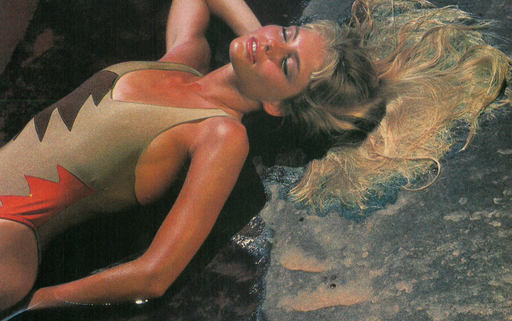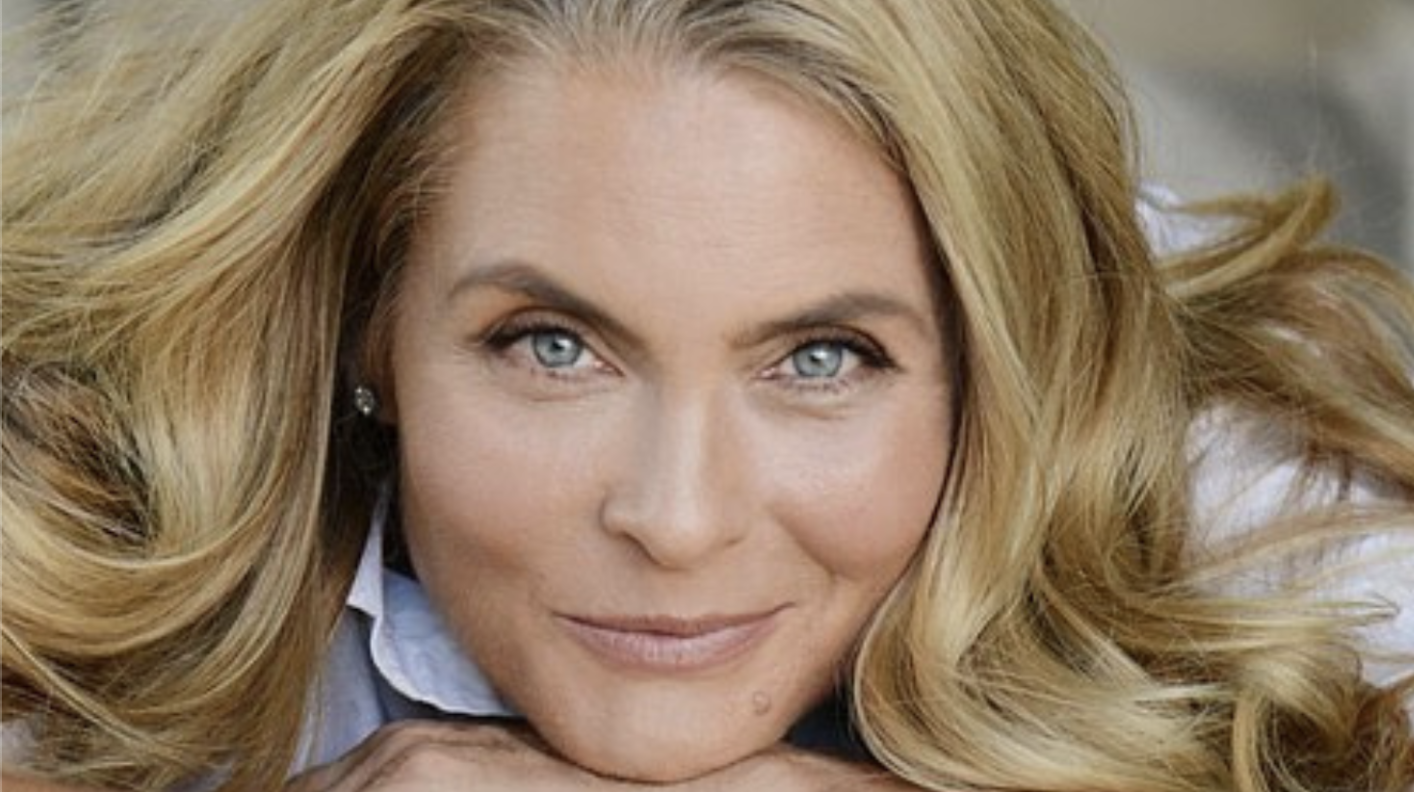In the world of fashion, where trends evolve and face change with the seasons, there are a few iconic figures who transcend the fleeting spotlight and leave an indelible mark on the industry. Kim Alexis, whose name is synonymous with grace, beauty, and empowerment, is a supermodel whose legacy has stood the test of time. Alexis has not only transformed beauty standards with her beautiful features and magnetic demeanor, but she has also dedicated herself to important causes that have inspired generations.
She has graced some of the world’s most iconic runways throughout her extensive career. Collaborations with major designers such as Calvin Klein, Ralph Lauren, and Versace solidified her image as a creative muse.
Her ability to segue easily from haute couture to sportswear demonstrated her versatility and adaptability, attributes that drew her to both the fashion elite and the general people.
Growing Up
She burst onto the modeling scene in the 1980s, a time when the definition of beauty was undergoing a revolution.
When Alexis was 17 years old and in high school, she was accepted into a pharmacy program at the University of Rhode Island. She was very involved in a variety of extracurriculars growing up, including being on the swim team and band. Being that Alexis felt she already had all of that handled, she decided to make some extra money by joining a modeling agency.
“Many people had said to me, ‘You’re pretty, you should model’ so I went to an agency in Buffalo,” Alexis said. “I had to go through a school before they would let me go to the agency back then, I mean this is the late 70s, like a charm school.”

“So I would show up with wet hair because I had just come from swim practice and I felt like I didn’t fit in with any of these women,” Alexis said, “To me, they were women. I was still 17, I felt like a girl and didn’t have the portfolio and the bag filled with lingerie because I was a tomboy.”
Being a supermodel in the 1970s and 1980s was a unique and transformative experience because the decades marked a pivotal era in the fashion industry’s evolution. Supermodels from this time, like Alexis were Cindy Crawford, Naomi Campbell, and others, who were more than just faces on magazine covers — they became cultural icons and symbols of beauty, style, and aspiration.
“One night I was in class and I got pulled out by the owner, and I thought I was getting kicked out because I felt like I didn’t belong, but instead she asked me ‘How would you like to go to New York City?’” Alexis said, “Initially I said no, I had my whole life planned, I wanted to be a pharmacist.”
After convincing, Alexis took some pictures and headshots and sent them to New York.
“And lo and behold, the agent that ran Elite Models decided he wanted to meet me, and he signed me onto a contract for a year,” Alexis said. “So I was sitting in a school where all those girls made me feel uncomfortable, and I’m the one who gets a guaranteed contract for a year from a huge talent scout in New York.”
Elite gained a reputation for its exceptional scouting efforts. John Casablancas, a charismatic figure with a keen eye for talent, scoured the globe for fresh faces that deviated from the conventional standards of beauty prevalent at the time.
First Job and Boulder Move
After Alexis graduated from high school and turned 18, she booked her first job. After she moved to New York, she traveled to Paris and Rome, where she landed her first magazine cover with Harper’s Bazaar within the first four days.
“My career took off immediately after that,” Alexis said.“I’ve done about 500 magazine covers, I would get 14 job offers a day, and I had national ads right away, so it was something I wasn’t planning but it did work out. It was successful.”
Though she spent most of her time in New York and Florida, Alexis briefly lived in Boulder after her split from her first husband, and after her son moved to Denver. Soon she found herself falling in love with who she became in Colorado.
“I just jumped into the car and started driving from Florida to Boulder with what I had in my car and my little chocolate lab, we made a home there,” Alexis said.
Alexis did a lot of hiking in the Rocky Mountains, exploring different parts of Colorado, and meeting new people. One of the girlfriends she met, went to high school with her now husband.
“I really enjoyed that time there and used it to heal and find myself, what I wanted, and who I was,” Alexis said.
Boulder’s allure lies in its ability to seamlessly blend urban amenities with the tranquility of nature. Kim Alexis, known for her graceful presence, found a home that mirrored her own balance of strength and serenity. The city’s abundant green spaces, hiking trails, and outdoor recreational opportunities align with Alexis’ commitment to an active and holistic lifestyle.
“But what’s fun was that you could get down to the city too, so I loved going down into Denver,” Alexis said.
Modeling Back Then
Though her time in Boulder was a peaceful and reflective time of her life, Alexis’ time in the fashion industry proved to be the opposite. The fashion industry in these decades exuded a sense of glamor and elegance. Supermodels were often photographed in opulent settings, wearing high-end designer clothing and accessories. They embodied a lifestyle that was aspirational and luxurious, setting trends and defining beauty standards of the time.
When shooting many of her covers Alexis said, “You’re usually in a room with maybe eight people, one’s hair, one’s makeup, one’s the photographer, the photographer’s assistant, and then normally someone from Vogue or Bazaar and their assistant.”
Supermodels of the ’70s and ’80s often developed close relationships with renowned fashion designers. These collaborations went beyond business partnerships; they were personal connections that resulted in memorable fashion moments.
“For covers, they would lay out a huge table filled with jewelry, scarves, or hats. Back then, the covers were just the model’s profile, and you might only see the hint of one earring or something, but they had everything ready,” Alexis said.
“The creative process itself was so small, and so it became like a family. You become very close and you can understand each other and you can work well, it was just very satisfying,” Alexis said.
One of Alexis’ favorite brands to work with or shoot for was Sports Illustrated because of her love for all things sporty and swimming. She still loves to be athletic by going on runs, biking, and hiking.
Modeling in a Digital Age
Unlike the digital age we now live in, the ’70s and ’80s had a more limited media landscape. Television, magazines, and billboards were the primary channels through which supermodels reached a global audience. This exclusivity contributed to the mystique surrounding these iconic figures and heightened their status as cultural symbols. Modeling and being on the cover of magazines was about the charm and class of the natural beauty and talent of a model.

“Back on the casting calls I used to do, it used to be all about your tear sheets, like the ads and magazines you’ve done. Now it’s become more about your social media numbers and how many followers you had, and how you could help influence in a whole different way that we never had,” Alexis said, “Those were the days, the 80s, where beauty was beauty and artistry was artistry.”
Alexis believes that because things are done so quickly and efficiently nowadays, it has expanded beyond being a talented model to include actresses and influencers as well.
“I think you’ve lost the term supermodel because there are not really girls that are just devoted to modeling any longer,” Alexis said.
One piece of advice Alexis had to share, especially after her experience being on Good Morning America, was to “keep your mouth shut, ask a bunch of questions, and learn from really great people, even if you don’t know what you’re doing.”
Kim Alexis Foundation
In the early 2000s, Alexis founded the “Kim Alexis Foundation,” an organization committed to supporting various charitable initiatives.
Through partnerships with organizations focusing on education, healthcare, and social justice, the foundation has become a driving force in empowering underprivileged communities. And as the years have passed, Kim Alexis’ influence has not waned. Her timeless beauty and enduring charisma continue to captivate new generations of admirers.
In an era where authenticity and inclusivity are celebrated more than ever, Alexis’ legacy remains a guiding light for aspiring models, activists, and individuals striving to redefine beauty and push for positive change.
“I think it’s really important for young people to hear that it’s okay to try something new and not know if you’re good at it, and try as many experiences and as much of life as you can get out of it, and just figure out your passion,” Alexis said. “Carry that confidence and that inner self of yours, who you are and what you represent, wherever you go.”
Kim Alexis, the supermodel who broke barriers, challenged norms, and dedicated her life to meaningful causes, remains a beacon of inspiration. With grace, poise, and an unwavering commitment to making a difference, Alexis has left an indelible mark on the world of fashion and beyond.






